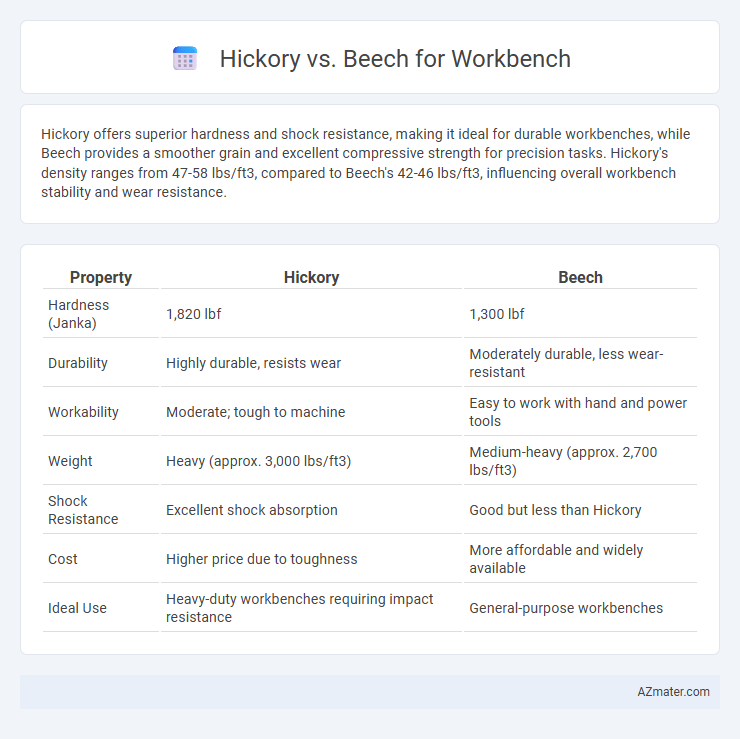Hickory offers superior hardness and shock resistance, making it ideal for durable workbenches, while Beech provides a smoother grain and excellent compressive strength for precision tasks. Hickory's density ranges from 47-58 lbs/ft3, compared to Beech's 42-46 lbs/ft3, influencing overall workbench stability and wear resistance.
Table of Comparison
| Property | Hickory | Beech |
|---|---|---|
| Hardness (Janka) | 1,820 lbf | 1,300 lbf |
| Durability | Highly durable, resists wear | Moderately durable, less wear-resistant |
| Workability | Moderate; tough to machine | Easy to work with hand and power tools |
| Weight | Heavy (approx. 3,000 lbs/ft3) | Medium-heavy (approx. 2,700 lbs/ft3) |
| Shock Resistance | Excellent shock absorption | Good but less than Hickory |
| Cost | Higher price due to toughness | More affordable and widely available |
| Ideal Use | Heavy-duty workbenches requiring impact resistance | General-purpose workbenches |
Introduction: Hickory vs Beech Workbenches
Hickory and beech are both popular hardwood choices for workbenches, each offering distinct characteristics that impact durability and work surface performance. Hickory is known for its exceptional hardness and shock resistance, making it ideal for heavy-duty tasks and high-impact use. Beech provides a fine, tight grain with moderate hardness, offering a smooth surface well-suited for precision work and woodworking projects where stability and a clean finish are important.
Wood Hardness and Durability Comparison
Hickory ranks among the hardest domestic woods, scoring approximately 1820 on the Janka hardness scale, making it highly resistant to dents and wear, ideal for a durable workbench surface. Beech, with a Janka hardness of about 1300, offers moderate hardness and good shock resistance, suitable for workbenches where some flexibility and less brittleness are preferred. Hickory's superior toughness and impact resistance provide enhanced durability under heavy usage, while Beech delivers stable performance with easier machining and smoother finishing.
Grain Patterns and Aesthetic Appeal
Hickory features a bold, dramatic grain pattern with contrasting dark and light streaks, creating a rustic and robust aesthetic ideal for heavy-use workbenches. Beech offers a fine, straight grain with a smoother texture and lighter, uniform color that provides a clean, elegant look suitable for precision tasks. Both woods ensure durability, but hickory stands out for its striking visual character, while beech excels in subtle sophistication and consistent appearance.
Workability: Machining and Shaping
Hickory offers superior shock resistance and toughness, making it ideal for heavy-duty workbench applications where durability is critical, but its hardness can challenge machining and shaping processes. Beech wood, while slightly less durable, excels in workability with a smoother grain that machines and shapes easily, providing clean cuts and fine finishes. When prioritizing ease of use in detailed machining and shaping, beech is often preferred, whereas hickory is chosen for its ability to withstand repeated impact and stress.
Resistance to Wear and Damage
Hickory is renowned for its exceptional resistance to wear and impact damage, making it a popular choice for heavy-duty workbenches that endure frequent hammering and heavy use. Beech offers moderate wear resistance with a fine, tight grain that resists denting but is generally softer and less durable than hickory under rigorous conditions. For workbenches requiring maximum durability and long-lasting performance, hickory outperforms beech in resisting abrasions, dents, and impact damage.
Stability and Movement Over Time
Hickory offers exceptional stability and minimal movement over time due to its dense grain and natural hardness, making it ideal for durable, long-lasting workbenches. Beech, while also stable, tends to absorb moisture more readily, which can lead to slight expansion and contraction under varying humidity conditions. Choosing hickory ensures consistent performance and structural integrity for workbench surfaces exposed to heavy use and fluctuating environments.
Cost and Availability of Hickory and Beech
Hickory, known for its high density and durability, is often more affordable and readily available in North America due to widespread harvesting and lower demand compared to Beech. Beech, prized for its smooth grain and uniform texture, tends to be more expensive and less accessible outside of Europe because of limited supply and higher import costs. Choosing between Hickory and Beech for a workbench depends on budget constraints and regional wood availability, with Hickory generally offering a cost-effective and durable option.
Environmental Impact and Sustainability
Hickory and Beech both offer unique environmental benefits for workbench materials, with Hickory known for its rapid growth and high density that contributes to durability and longevity, reducing the need for frequent replacements. Beech, sourced mainly from sustainable European forests, supports biodiversity and carbon sequestration efforts due to responsible forest management practices. Choosing certified wood from these species helps minimize ecological footprints, promoting sustainable woodworking and conservation.
User Experiences and Expert Recommendations
Hickory offers exceptional durability and shock resistance, making it a favorite among craftsmen who demand heavy-duty performance for workbenches. Beech provides a smoother surface and is easier to machine, preferred by users valuing precision and a refined finish in woodworking projects. Experts recommend hickory for high-impact tasks and beech for detailed work, emphasizing the choice based on specific workshop needs and project types.
Conclusion: Choosing the Best Wood for Your Workbench
Hickory offers exceptional shock resistance and durability, ideal for heavy-duty workbenches subjected to frequent impact. Beech provides a smooth texture and excellent stability, making it suitable for precision tasks and a refined finish. Selecting between Hickory and Beech depends on the workbench's primary use: Hickory for toughness and resilience, Beech for stability and fine woodworking applications.

Infographic: Hickory vs Beech for Workbench
 azmater.com
azmater.com